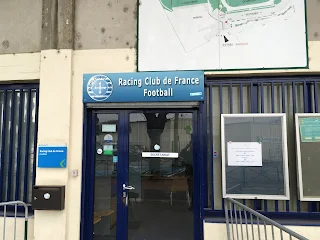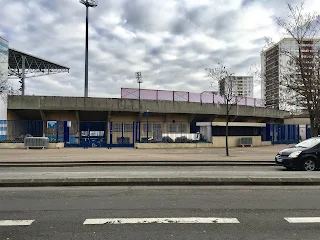Racing Club de France football Colombes 92 is a football club from the suburb of Colombes in the French capital of Paris, which has gathered a long and interesting history in several guises since its formation in 1882. Racing was formed as a sports club with several departments offering members competition in several different sports
The football club played at their Croix-Catelan Stadium and hosted athletic events during the 1900 Olympics. In 1907, the club moved into Stade du Matin, a new stadium built in the suburb of Colombes, to the north west of the city. The stadium name was changed to Stade de Colombes in 1920 and then Stade Olympique de Colombes as it staged the 1924 Olympics.
After a few decades of competing in regional football, Racing Club de France changed their title to Racing Club Paris and became a founder member of the National, as Ligue 1 was originally known as for the 1932-33 season, a couple of years after ending as losing finalists in the Coupe de France to FC Sète.
Racing were crowned as champions of France in 1935-36 as they lifted the Division 1 title as well as completing the double by lifting the Coupe de France with a 1-0 victory on home turf against FCO Charleville in Stade Olympique Yves-du-Manoir, as the stadium had been retitled.
The Stade Olympique Yves-du-Manoir would go on to host matches in the 1938 FIFA World Cup, including the final, which saw Italy defeat Hungary 4-2 with a crowd of 45,000 attending.
The Coupe de France was regained in 1939 following a 3-1 win in front of 52,431 fans against OSC Lille. Racing retained the trophy twelve months later as Olympique de Marseille were defeated 2-1 at Parc des Princes.
The capacity of the Stade Olympique Yves-du-Manoir was extended to 60,000 as it became the major arena in the country, hosting the home games of both the French national rugby union and football teams.
The 1940s were also good to Racing in the Coupe de France as they lifted the trophy in 1945 with a 3-1 win over OSC Lille and again in 1949 when the same opponents were beaten 5-2, with both games being played on home turf in Colombes.
Racing continued to ply their trade in Division 1 for the next dozen years before ending as runners-up in 1960-61 and 1961-62. However, the club hit a financial crisis, which led to relegation to Division 2 in 1963-64 despite the goals of Guy Van Sam, Francis Magny and Michel Watteau.
The club returned to the title of Racing Club de France in 1966 as they returned to Division 2. However, from 1967 the club were once again resigned to playing lower league football. By that time, both Paris Saint-Germain and, to a lesser extent, Paris FC, had stolen a march on Racing and had sped away into the distance.
In 1982, the businessman Jean-Luc Lagardère decided that he wanted his own football club to compete with PSG in the capital. His idea was to merge Racing with Paris FC, but owing to the accounts of PFC being unavailable, the board of Racing refused to grant the move.
Instead, Lagardère bought Paris FC with their 4M Franc debt and their place in Division 2, merging the clubs and changing their title to Paris Racing. Paris FC kept their reserve and youth teams and dropped down to the fourth-tier CFA to continue in their own entity. Meanwhile, Monsieur Lagardère had big plans for Racing.
He employed Alain de Martigny as head coach, and new players, including Raúl Nogués and Rabah Madjer, were signed as Racing were promoted to Division 1 in 1983-84 as runners-up of Group B.
However, the team were relegated despite new signings Pierre Sither and international defender Philippe Mahut adding strength to the side. Further signings in the shape of Eugène Kabongo and Maxime Bossis arrived at the club under new head coach René Hauss as the team won the Division 2 title in the 1985-86 season.
Enzo Francescoli, Pierre Littbarski, Thierry Tusseau and Luis Fernandez were added to the squad in big money moves, but the side only finished in thirteenth position. Artur Jorge, who had led FC Porto to European Cup glory, came in to lead the team.
The club was renamed Matra Racing in a sponsorship deal, yet despite all the investment, the team fell away to finish in seventh position in 1987-88. The crowds dropped from over 20,000 to just 7,000 as the club failed to grab the imagination of the Paris public, who stayed loyal to PSG.
The 1988-89 campaign nearly ended in relegation as Lagardère’s dream faded with players departing as the owner departed, having lost up to 300M francs during his spell with the club. The Matra sponsorship ended as the club name was changed to Racing Paris 1.
The team was relegated at the end of the 1989-90 campaign under head coach Henryk Kasperczak, dropping down to regional football in the Division d'Honneur. Over the next few years, many changes of title occurred at the club. In 1992, they became Racing 92, Racing Club de France 92 from 1995, and then Racing Club Paris from 1999.
More changes followed, with the team being known as Racing Club de France from 2005, Racing Club de France football 92 from 2007 and then Racing Club de France Levallois 92 from 2009 until changing to Racing Club de France Colombes 92 in 2012. During that time, the Greek Georgios Kintis looked to buy the club, but couldn’t come to an agreement with the owners.
In 2009, the commune of Levallois gave its backing in return for acknowledgement in the club's title as the club rebuilt and reached the fourth tier while playing away from Colombes. However, the authorities overseeing financial administration in French football relegated the club to the Championnat de France Amateur 2 after it was revealed that Racing were €500,000 in debt.
In 2012, Racing returned to Stade Olympique Yves-du-Manoir before eventually deciding to play games in the smaller Stade Lucien-Choine, which is located next door, while playing in the Paris Île-de-France Division Honneur.
Racing played in the fifth-tier Championnat National 3 Group Île-de-France in the inaugural 2016-17 season, with Racing finishing bottom of the table and being relegated to the Paris Île-de-France Division Honneur. Promotion was achieved at the first attempt as Racing returned to their previous National 3 group
The side finished in fourth place in 2018-19 before a fifth place was achieved in the truncated 2019-20 season as the team decamped once again at Stade Lucien-Choine under head coach Guillaume Norbert. The Group L, Île-de-France fifth-tier division was won in 2021-22, where they ended up as Group A runners-up the following season, with Arnold Lamb Luth scoring the goals.
The side was switched to Group C in 2023-24, where they ended in the relegation places and went back down to National 3. Home games were played at Stade Léo Lagrange in Poissy, the following season, as the side ended as runners-up in Group G, before being switched to Group D in 2025-26 as Baila Dia coached the side.
Racing Club de France football will play in the Championnat National 3 Group D in the 2025-26 season.
My visit
Wednesday 8th February 2017
I’d been in Paris for a couple of days and watched Red Star in action in exile at Stade Jean Bouin and then PSG take on Lille at Parc des Princes the following evening. I was heading to more Ligue 1 action in Angers, but I wanted to visit Colombes first.
It was a pleasant midweek morning as I set out from my room at the Hotel Baby in Paris’s 2nd arrondissement for a walk down to the banks of the Seine while sussing out some bars for my return later in the evening.
Having reached Pont Neuf, I took a couple of metros with a change at Pyramides to reach Saint-Lazare, where I went upstairs to take a train to Le Stade. I wasn’t entirely sure that I could use my travel tickets, so I ensured I kept a close lookout for guards on the twenty-minute journey!
On arrival, I walked around fifteen minutes along Rue Alexis Bouvier, the main Boulevard de Valmy and then Boulevard Pierre de Coubertin, passing several sports pitches belonging to Racing. My final turn took me into Rue Paul Bert behind the main stand of the Stade Olympique Yves-du-Manoir.
Continuing past the main structure, I was delighted to find an open gate into the complex. Racing was still very much a sports club, catering for golf, athletics, badminton, volleyball, skiing, tennis, shooting, hockey, judo, kick boxing, water polo, fencing, as well as football and rugby union.
Walking past club buildings, I found an entrance that led me through a tunnel and to the corner of the pitch. I took plenty of photos of the now disused terrace behind each end as well as the large seated stands on either side of the pitch.
It was an arena steeped in history, having staged an Olympic Games and a World Cup Final. The capacity was now massively cut, with the French national rugby union side playing their final game there in 1972, when the renovated Parc des Princes was opened.
The national football team played their final game at Colombes in 1975, while the last Coupe de France final was played in the stadium in 1971, as 46,801 spectators witnessed Stade Rennais defeat Olympique Lyonnais 1-0 to lift the cup.
The stadium was portrayed in the classic movie ‘Escape to Victory’, although the actual filming took place at Hungária Körúti Stadion in Budapest.
I walked away, delighted to have visited yet another Olympic venue. My day had plenty to go. I crossed the road to catch the 164 bus to Villiers–Bineau to go in search of food and drink before boarding my Flixbus service down to Angers.


















No comments:
Post a Comment